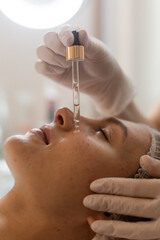Your skin is your largest organ, shielding you from germs, repelling water, and covering blood vessels, nerves, and other vital things. So, when something goes wrong with your skin, you want help from a specialist.

Montgomery Dermatologists are trained to diagnose and treat various skin issues. They also perform cosmetic procedures to improve appearances.
Acne occurs when hair follicles connected to oil glands become clogged with dead skin cells and sebum (oil). It is most common on the face, shoulders, neck and chest because these areas have the most oil-producing glands. Acne can cause scarring that can last a lifetime if not treated early and correctly. It typically starts in teenagers due to hormonal changes, but can also occur in adults and sometimes even into their thirties or forties. Acne can have a negative impact on a person’s self-esteem, especially if it is severe or persistent.
Dermatologists can diagnose acne by examining the skin, but they will consider other factors such as age and the severity of the condition when developing a treatment plan. Symptoms vary, but may include spots or pus-filled bumps on the skin’s surface, enlarged pores or hair follicles and cysts that are large, painful and deep under the skin.
Treatment options for mild acne, or acne vulgaris, are a topical cream, gel, antibiotics or benzoyl peroxide. These medications work to unclog the pores, reduce inflammation and kill bacteria. Topical retinoids, which are derivatives of vitamin A, can help to reduce scarring and promote skin renewal. They can also be used in conjunction with other topical treatments to improve their efficacy.
Other medications, including oral contraceptives and hormone replacement therapy, are also available to help control acne in women. These medications work to lower the amount of androgen in the body, which can help slow sebum production.
For people who continue to have acne, the dermatologist may recommend a different medication or a procedure. Surgical procedures may be recommended to remove the deeper pimples or cysts that have formed under the skin. Laser therapy can also be helpful to control inflammation and improve the appearance of scars.
To prevent future breakouts, dermatologists advise people to wash their skin with a gentle soap or cleanser, and to avoid over-washing or scrubbing. They may also suggest using noncomedogenic skin products, which are less likely to clog the pores. It is also important to avoid squeezing or picking at the skin, as this can make acne worse and lead to permanent scarring.
Pimples
Pimples form when hair follicles become clogged with excess oil, dead skin cells and bacteria. Acne is the most common disease in the world and it can affect anyone. Mild acne can be cleared with over-the-counter treatments, but more serious acne needs to be treated by a dermatologist because it can lead to scars. Pimples, also known as blemishes or zits, are most often found on the face and neck, but they can appear on the shoulders, back, chest and arms as well. Pimples can be painful and embarrassing, especially for teenagers. In severe cases, acne can cause inflammation and lead to swollen, red, inflamed skin called nodules or cysts.
Acne is a medical condition, but it can have psychosocial and psychological effects as well. For example, if a pimple is affecting a person’s self-image or making them feel embarrassed to go out in public, they may not be interested in socializing and they could become depressed or suicidal.
The most basic type of acne lesion is a comedone, which is basically a clogged hair follicle filled with dead skin and excess oil. When a comedone is exposed to air, it becomes black or dark in color because the oil oxidizes. If a clogged pore stays closed and gets infected with bacteria, it can become a small, red bump called a pimple or a pus-filled lesion called a pustule. Pustules are very sensitive to touch and should not be touched, as picking or squeezing can lead to scarring and infection.
The most serious types of acne are nodules and cysts. Nodules are large, inflamed lesions that feel firm to the touch and can be very painful. They develop deep in the skin and can lead to scars if not treated by a dermatologist. Cysts are painful, fluid-filled lesions that resemble boils and can be very dangerous. They should not be picked or squeezed and should only be treated by a dermatologist. A doctor can drain these lesions of their contents by injecting them with medication. They can also prescribe medications to help them disappear.
Hair Loss
Hair loss is a common problem. People typically lose 50 to 100 strands of hair every day and new growth replaces it, but some conditions cause the body to shut down hair follicles or prevent them from growing hair. When the problem isn’t caused by genetics, a dermatologist can help people manage and treat it.
Dermatologists are able to diagnose hair loss by taking a history and doing a physical exam. They will ask questions about the person’s family history, diet and lifestyle. They may also recommend blood tests to see if any specific illnesses are contributing to the condition.
Inflammatory skin diseases that affect the scalp, including chronic cutaneous lupus erythematosus, classic Brocq pseudopelade and folliculitis decalvans, can cause hair loss by inflaming and scarring the scalp and destroying the hair follicles. They are not reversible and usually cause permanent hair loss, but a dermatologist can prescribe medications to control the symptoms.
Some people develop alopecia areata, an autoimmune disease that causes the immune system to attack healthy hair follicles and stop them from growing hair. It can cause thinning, patchy hair loss or baldness, depending on the type of alopecia and its severity. It is not reversible, but dermatologists can offer medications that can help stimulate hair growth.
Some people with alopecia areata notice that their hair grows back after they get treatment for the underlying health problem. For example, chemotherapy and radiation treatment for cancer can lead to hair loss by damaging the cells that make follicles grow hair. Once the cancer treatment is complete, a dermatologist can prescribe medication that can help stimulate hair growth.
Anti-Aging
Dermatologists focus on preserving the health and appearance of your skin as you age. This can involve surgical and nonsurgical treatments. Although natural aging affects all organs and tissues, the skin provides first visible signs of time passing. Dermatologists can slow down the process and erase time vestiges with cosmetic treatments.
The most common and important anti-aging treatment is using sunscreen every day. Choose a product that offers broad-spectrum coverage and has an SPF of 30 or higher. A daily moisturizer is another great anti-aging treatment. Look for one that contains an active ingredient like hyaluronic acid or retinol to minimize fine lines.
Exfoliation is also essential for reducing the appearance of fine lines and wrinkles. Choose a scrub or peel that contains an alpha-hydroxy acid such as glycolic acid. Look for products that have clinically proven results. A dermatologist may recommend an anti-aging serum that has been tested in a controlled setting.
Smoking narrows the blood vessels in the outer layers of the skin, causing it to sag and develop fine lines prematurely. It also damages collagen and elastin, which are the fibers that give your skin strength and elasticity. Try to quit smoking if you want to improve your skin tone and texture.
Your diet is also an important part of a healthy lifestyle and can help prevent wrinkles. Avoid eating foods high in salt, which cause your body to retain water and make you look bloated. In addition, drink plenty of water to stay hydrated.
A dermatologist can prescribe anti-aging creams and serums to smooth out fine lines and increase collagen production. They can also prescribe injectables, such as botulinum toxin and dermal fillers, to reduce the appearance of wrinkles. Dermal fillers can add volume to the cheeks and eyes, and synthetic collagen or hyaluronic acid can fill in wrinkles and create fuller lips. Injectables can also be used in combination with muscle relaxers to produce a liquid face lift.
Dermatologists can perform laser and light therapies to remove sun damage, resurface the skin and promote new cell growth. Lasers can also be used to treat rosacea, hyperpigmentation and acne scarring.


